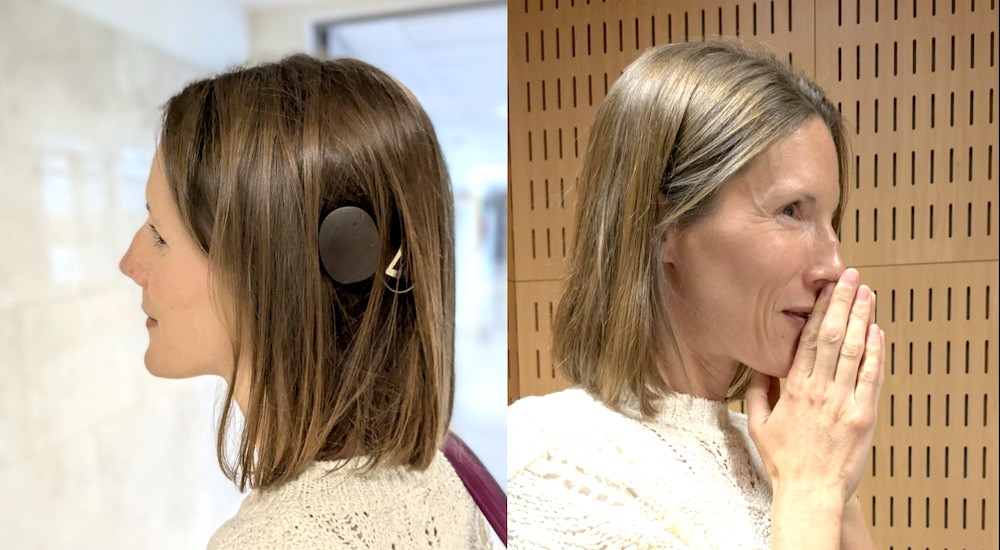"Bloody deafness." The hearing loss that condemned surrealist filmmaker Luis Buñuel to isolation
"I sometimes wonder if it's true that blind people are happier than the deaf," said Buñuel in his autobiography.
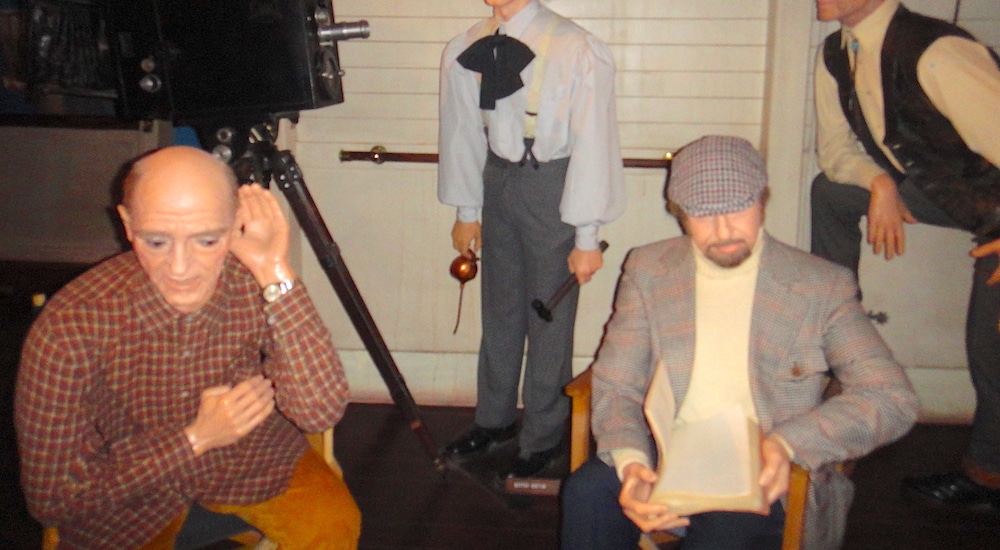
Luis Buñuel’s films, which tantalisingly explore how to challenge what our senses tell us, were the work of a spirited rebel who, in his youth, boxed, played the violin and banjo, and mingled in a vibrant professional and social life with some of the most brilliant minds of the interwar period.
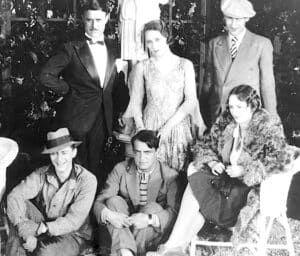
From Luis Buñuel: A Life in Letters (Bloomsbury)
Buñuel (below centre), at 30, during the making of his surrealist masterpiece L’Age D’Or (The Golden Age) in 1930, and surrounded by cast and production figures, all of whom were contributing to a film whose strong imagery would lead to riots.
The famed vigour of filmmaker Luis Buñuel at the heart of the Surrealist movement was sublimely clarified in films such as L’age D’or, Belle du Jour, and The Discreet Charm of the Bourgeoisie, many simultaneously featuring for decades among the top places in critics’ polls.
His work made us challenge what our senses tell us, and he adored to use his own senses. But, tragically, the gradual loss of his own hearing sense in the prime of his life was to make his own surroundings surrealistic in the most depressing way: he would keep away from good friends, major cinema events, and settle for early bedtimes to limit the “suffering”.
Despite the iconoclastic beliefs that led him and fellow surrealists to want to expose the hypocrisy and phoniness of the bourgeois establishment, the young Buñuel was a lover of music from the Western classical repertoire. Beethoven, Debussy, Franck, Schumann, and Wagner were his favourites. He played violin in his youth, then banjo as a young man residing in Paris. At the time of writing his autobiography (written with the help of his long-time scriptwriter Jean-Claude Carriere), he complained: “One of the greatest tragedies in my life is my deafness, for it’s been over twenty years now since I’ve been able to hear notes. When I listen to music, it’s as if the letters in a text were changing places with one another, rendering the words unintelligible and muddying the lines. I’d consider my old age redeemed if my hearing were to come back, for music would be the gentlest opiate, calming my fears as I move toward death.” *
Lost loved sounds and forsaken friends
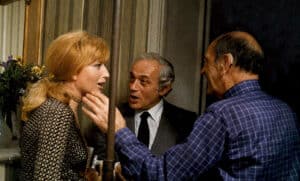
From Luis Buñuel: A Life in Letters (Bloomsbury)
1974, filming The Phantom of Liberty. Buñuel (right), hearing aid in place, and long-time collaborator producer Serge Silberman (centre) with Italian star Monica Vitti.
Along with the music he lost were many favourite sounds, as well as social and work-related events that became torturous for him.
“No sound is lovelier than that of the rain. There are times when I can hear it, if I wear my hearing aid, but it’s not quite the same, of course. ” *
Though Buñuel’s deafness had affected him for some 20 years when he wrote, in 1963, from Mexico City, to Guillermo de Torre (dadaist and essayist, brother-in-law of Jorge Luis Borges), it was clear how tired he was with the struggle to hear:
“I never answer the telephone, and when I did that time, the thing I always fear will happen happened. I can’t hear names and whoever is calling thinks I’ll get them if they shout loud enough. A hopeless task. All that happens is that I get anxious, unable to associate ideas, almost obnubilated. To me your name [Guillermo de Torre] sounded like Yerma de Sorra (I turn the t’s into s’s and vice versa).” **
He declined invitations, such as one in 1966 to visit the country home of the acclaimed journalist and cinema writer, Georges Sadoul:
October 24, 1966
“I’m going to leave it a few days, because I spend Sundays alone in my room to give my terrible hearing a rest from the daily racket.”
The mental battle involved in mingling with crowds led to Buñuel cancelling even such important outings as collecting awards, as on August 29, 1969 when he informed the director of the Venice Film Festival, Ernesto Laura:
“I have been suffering for two days now from an unpleasant nervous tension that has had a particularly bad effect on my hearing. For the moment I have lost almost all auditory function. The doctor says a few days of treatment should begin to correct this, relatively-speaking, that is, as I’ve had trouble with my hearing for some time now: under these conditions it would be unwise of me to take on the meetings, conversations, interviews, etc., to which you have so kindly invited me. So, it is with sincere and deep regret that I find myself having to cancel my trip to Venice.”
Frustration and Isolation
One letter from the Bloomsbury publication Luis Buñuel: A Life in Letters shows just how early Buñuel was affected by hearing loss, but then he was able to be fairly frivolous about it.
To Gustavo Pittaluga (composer of many of Buñuel’s soundtracks) Ollibood [Hollywood]
February 15, 1945
“Forgive me for saying how healthy and handsome I am at the moment. The only thing holding me back now is my deafness, which, if it carries on, will soon have me composing a patétique or painting a series of caprichos.”
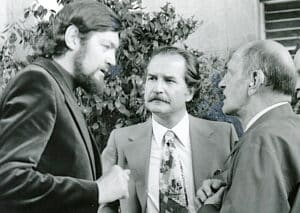
From Luis Buñuel: A Life in Letters (Bloomsbury)
Mexico City, 1975. Buñuel, his hearing aid visible, celebrates his birthday wiht, left to right, writers Julio Cortazar and Carlos Fuentes.
By 1964, in a letter from Mexico City to the French film producer, Pierre Braunberger, Buñuel admitted to being ˝a slave to my deafness˝. Five years later, to his friend and scriptwriter, Jean-Claude Carriere, his lines captured the isolation his deafness had caused: Thanks to my deafness, I have my lunch apart from the others, supper alone, then bed at 8:30. The frivolity gone, he moaned in a 1972 letter to the Mexican novelist Carlos Fuentes:
“I am at your service, although my cloistered life precludes certain excesses. I get up at 06:30 and go to bed by 9pm at the latest. I have to see so many people and the nervous tension at the end of the day is most unpleasant. Bloody deafness.”
And just five years from the end of his life, his humour on the subject had become as dry as his favourite tipple:
To Eduardo Ducay
Mexico City April 17, 1978
“As well as being deaf, I shall soon be using two pairs of glasses like Goya. It makes me quite isolated and my only comfort is the dry martini that transports me momentarily back to my youth.”
Martini or not (and the director took just one, religiously, every afternoon, to fire his imagination), the hardship Buñuel experienced through having lost his hearing is very clear in his letters.
Hearing healthcare professionals and experts knowledgeably underline just how disorientating and tiring this loss is for those who must endure it. Prof. Kevin Munro, NIHR Senior Investigator and Ewing Professor of Audiology in the Manchester Centre for Audiology and Deafness, University of Manchester, UK, agrees that avoiding gala evenings and people speaking a variety of languages, as well as eating meals apart, are normal and understandable responses by hearing loss patients to challenging situations. Given Buñuel’s testimony on the discomfort he experienced, Buñuel’s assertion (in the introduction to the Bloomsbury-published collection of correspondence) that he “would use his well-known hearing problems to excuse himself from public appearances” should not be taken too literally. Even if, at the beginning of his conversations with the novelist Max Aub, he confessed “you don’t need to raise your voice; I hear well with my hearing aid”, the reality of Bunuel’s situation is repeatedly reinforced in his letters. Hearing loss is discouraging. In My Last Breath, the aged director ruminated: “Even today, I sometimes wonder if it’s true that blind people are happier than the deaf. I tend to think not, yet I once knew an extraordinary blind man named Las Heras who’d lost his vision when he was eighteen and had tried many times to commit suicide.”
Type and cause of Buñuel’s deafness
Bunuel’s hearing loss seems, from his writings, to involve either otosclerosis or auditory nerve damage, or both. In 1950, in a letter to Lulú Jourdain, the wife of painter Hernando Viñes, the director claimed “I have ‘sclerosis’ in both ears and I’m fairly deaf.”
In a 1964 letter to writer José Rubia Barcia, he points to an auditory nerve problem referred to in an article Barcia sent him:
“That cutting about diseases of the ear was very interesting, but it only confirmed what I already knew: that everything is curable except problems with the auditory nerve, which is precisely what is wrong with my ears.”
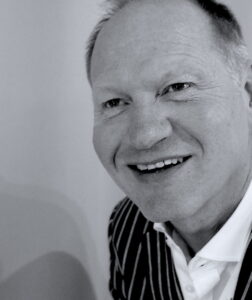
©PW Professor Kevin Munro
- Research expert Prof. Kevin Munro accepts that Buñuel may have been misdiagnosed at some point, but suggests the disorder could be more complex: “Otosclerosis commences in one ear but in some cases progresses to bilateral. So, it can cause a hearing loss in both ears. Sensorineural/permanent deafness is often referred to as neural deafness but it can (and usually does) involve the cochlear and the sensory cells,” Prof. Munro explains. “I believe that longstanding otosclerosis (conductive hearing loss in the middle ear) can spread into the base of the cochlea and can cause a sensorineural (wrongly referred to as auditory nerve) deafness. So, someone with otosclerosis will have a conductive hearing loss but over time this might become mixed (conductive and sensorineural). I do not know how common this is. In Bunuel’s case this might be the explanation.” But the expert confirms that ”individuals with conductive otosclerosis hear with a hearing aid.” Today, would Buñuel’s otosclerosis have been more effectively treated? “Otosclerosis is managed in three ways,” points out Munro:
- Sodium fluoride or/and calcium have both been proposed as slowing otosclerosis but their use is controversial.
- Hearing aid (HA): excellent outcome in people with otosclerosis because hearing loss that prevents the conduction of sound to the inner ear is not associated with any distortion. A hearing aid is great at restoring audibility in these patients and they don’t usually have the commonly reported difficulty hearing in background noise that is a characteristic of age-related hearing loss.
- Surgery: a stapedectomy involves removing the damaged stapes bone from the middle ear and replacing it with a prosthesis. It can be highly effective BUT there is a risk that the surgery can cause a total hearing loss (perhaps one in one hundred and maybe ten percent get no benefit from surgery. Also, in my experience, the benefit of surgery might be temporary because the otosclerosis can return).
“An extrovert might be happy to try surgery because they don’t mind taking risks. An introvert might go for the HA option. I would always suggest starting with the HA option because the result can be great and there is nothing to lose,” affirms Munro.
The surrealist imagination, and the possible cause of his loss?
As with all surrealists, Buñuel’s work focused sharply on sense data, in some key way fulfilling the mission determined the by 19th-century poet Arthur Rimbaud as the “derangement of the senses”.
In Buñuel’s 1970 film Tristana, the spectator is drawn into scenes featuring deaf characters through the use of exaggerated bell chiming or gushing water, all metaphors for the distorted sounds Buñuel himself experienced. His films often supersized sounds or played with speech, as they did with visual data.
Images from Buñuel’s childhood in Aragon, Spain stayed strong in Buñuel’s imagination throughout his life, though many surfaced in his early work. In a keen 1929 letter to his student friend from the famous Generation of 27, José Bello, he mentions the title of a book he intends to publish – Un Chien Andalou (An Andalusian Dog)- “which made Dalí and me piss ourselves laughing when we came up with it”, sending Bello his poem, The Rainbow and the Poultice, which contains the lines:
In a few minutes two salivas
will come down the street leading
a school of deaf-dumb children by the hand.
Would it be rude of me to vomit a piano on them/ from my balcony?
Buñuel and Dali’s cinema masterpiece of that same year made use of the title Un Chien Andalou. From the surrealist poem to the surrealist film, the piano had become two pianos, each containing a dead, decomposing donkey. A year later, in their next film L’Age D’or (The Golden Age), the protagonist’s fit of jealousy is accompanied by a soundtrack of ritual Easter drumming from Buñuel’s home village, Calanda. He used the drums several times in his films.
“Nowhere are they beaten with such mysterious power as in Calanda, without pause from noon on Good

Bloomsbury
The Easter drums of Calanda, in Aragon (Spain)- 24 hours constantly at up to 120 decibels.
Friday until noon on Saturday. Up until recently, I often beat the drums myself,” he confessed in his autobiography. “As the bell tolls the noon hour, the drums suddenly fall silent, but even after the normal rhythms of daily life have been re-established, some villagers still speak in an oddly halting manner, an involuntary echo of the beating drums.”
The 24-hour drumming of Calanda has been measured at 120 decibels. Buñuel was exposed to this throughout his young life and periodically, he says, in later life.
Could his beloved drums of Calanda have caused damage leading to his hearing loss? It depends on susceptibility, says Prof. Munro: “Excessive exposure to loud sound can damage hearing. Drums can certainly be loud. The question is was the duration of exposure so excessive that it resulted in damage? Individual susceptibility varies so a proportion of the population (for genetic or/and environmental factors) may be more susceptible and end up with damaged hearing.”
Whatever the cause of his hearing loss, Buñuel lived with it disconsolately for some forty years, his love of music destroyed, his social life dismantled. In the Matthew Lau book, Sounds Like Helicopters: Classical Music in Modernist Cinema, the author quotes an interview with Buñuel that reflects how he gradually abandoned non-diegetic music (not existing within the world of the film itself) in his works, quoting the surrealist: “I like natural sound. A zipper, a glass on a table. I can’t bear music put onto a film any longer. Perhaps it’s because I am deaf.”
*My Last Breath
**Luis Buñuel – A Life in Letters
Source: First published in Audiology News UK (Audio Infos UK) issue 132 January 2020

